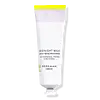What's inside
What's inside
 Key Ingredients
Key Ingredients

 Benefits
Benefits

 Concerns
Concerns

No concerns
 Ingredients Side-by-side
Ingredients Side-by-side

Water
Skin ConditioningHelianthus Annuus Seed Oil
EmollientGlycerin
HumectantBetaine
HumectantMethylpropanediol
SolventPolyacrylate Crosspolymer-6
Emulsion Stabilising1,2-Hexanediol
Skin ConditioningSimmondsia Chinensis Seed Oil
EmollientCarbomer
Emulsion StabilisingGlyceryl Caprylate
EmollientSodium Hyaluronate
HumectantSodium Hydroxide
BufferingSodium Phytate
O-Cymen-5-Ol
AntimicrobialTocopherol
AntioxidantPolyglutamic Acid
Skin ConditioningWater
Skin ConditioningGlycerin
HumectantGlyceryl Stearate
EmollientCetyl Alcohol
EmollientNeopentyl Glycol Diheptanoate
EmollientGlyceryl Caprylate
EmollientSqualane
EmollientPalmitoyl Tripeptide-38
Skin ConditioningCaprae Lac
Skin ConditioningMilk Protein
Skin ConditioningLactose
HumectantBifida Ferment Lysate
Skin ConditioningBakuchiol
AntimicrobialMelatonin
AntioxidantHyaluronic Acid
HumectantIsododecane
EmollientMelia Azadirachta Flower Extract
Skin ConditioningStearic Acid
CleansingGlyceryl Stearate Citrate
EmollientHydroxyacetophenone
AntioxidantPanthenol
Skin ConditioningCoccinia Indica Fruit Extract
Skin ConditioningCarbomer
Emulsion StabilisingAllantoin
Skin ConditioningXanthan Gum
EmulsifyingCaprylhydroxamic Acid
Glyceryl Laurate
EmollientBetaine
HumectantSodium Hydroxide
BufferingCentella Asiatica Extract
CleansingHydroxypropyl Cyclodextrin
MaskingSpinacia Oleracea Leaf Extract
Skin ConditioningSodium Carbonate
BufferingPropanediol
SolventTephrosia Purpurea Seed Extract
Skin ConditioningAcetyl Hexapeptide-8
HumectantGardenia Florida Fruit Extract
Skin ConditioningMaltodextrin
AbsorbentWater, Glycerin, Glyceryl Stearate, Cetyl Alcohol, Neopentyl Glycol Diheptanoate, Glyceryl Caprylate, Squalane, Palmitoyl Tripeptide-38, Caprae Lac, Milk Protein, Lactose, Bifida Ferment Lysate, Bakuchiol, Melatonin, Hyaluronic Acid, Isododecane, Melia Azadirachta Flower Extract, Stearic Acid, Glyceryl Stearate Citrate, Hydroxyacetophenone, Panthenol, Coccinia Indica Fruit Extract, Carbomer, Allantoin, Xanthan Gum, Caprylhydroxamic Acid, Glyceryl Laurate, Betaine, Sodium Hydroxide, Centella Asiatica Extract, Hydroxypropyl Cyclodextrin, Spinacia Oleracea Leaf Extract, Sodium Carbonate, Propanediol, Tephrosia Purpurea Seed Extract, Acetyl Hexapeptide-8, Gardenia Florida Fruit Extract, Maltodextrin
 Reviews
Reviews

Ingredients Explained
These ingredients are found in both products.
Ingredients higher up in an ingredient list are typically present in a larger amount.
Betaine is a common humectant (a substance that promotes retention of moisture). It's known to be gentle on the skin and can help balance hydration.
This ingredient is best for improving hydration and soothing irritated skin. Studies also show it helps even out skin tone.
Fun fact: Betaine is naturally created in the skin and body. The kind found within cosmetic products can be either plant-derived or synthetic.
Another name for betaine is trimethylglycine.
Learn more about BetaineCarbomer is a polymer of acrylic acid. Its main role is to create a gel consistency.
A high amount of carbomer can cause pilling or balling up of products. Don't worry, most products contain 1% or less of carbomer.
Glycerin is already naturally found in your skin. It helps moisturize and protect your skin.
A study from 2016 found glycerin to be more effective as a humectant than AHAs and hyaluronic acid.
As a humectant, it helps the skin stay hydrated by pulling moisture to your skin. The low molecular weight of glycerin allows it to pull moisture into the deeper layers of your skin.
Hydrated skin improves your skin barrier; Your skin barrier helps protect against irritants and bacteria.
Glycerin has also been found to have antimicrobial and antiviral properties. Due to these properties, glycerin is often used in wound and burn treatments.
In cosmetics, glycerin is usually derived from plants such as soybean or palm. However, it can also be sourced from animals, such as tallow or animal fat.
This ingredient is organic, colorless, odorless, and non-toxic.
Glycerin is the name for this ingredient in American English. British English uses Glycerol/Glycerine.
Learn more about GlycerinGlyceryl Caprylate comes from glycerin and caprylic acid, a fatty acid from coconut. It has emollient and emulsifier properties.
As an emollient, it helps hydrate your skin. Emollients work by creating a barrier on your skin to trap moisture in, helping to keep your skin soft and smooth.
On the other hand, emulsifiers prevent ingredients (such as oil and water) from separating.
Learn more about Glyceryl CaprylateSodium Hydroxide is also known as lye or caustic soda. It is used to adjust the pH of products; many ingredients require a specific pH to be effective.
In small amounts, sodium hydroxide is considered safe to use. However, large amounts may cause chemical burns due to its high alkaline.
Your skin has a natural pH and acid mantle. This acid mantle helps prevent harmful bacteria from breaking through. The acid mantle also helps keep your skin hydrated.
"Alkaline" refers to a high pH level. A low pH level would be considered acidic.
Learn more about Sodium HydroxideWater. It's the most common cosmetic ingredient of all. You'll usually see it at the top of ingredient lists, meaning that it makes up the largest part of the product.
So why is it so popular? Water most often acts as a solvent - this means that it helps dissolve other ingredients into the formulation.
You'll also recognize water as that liquid we all need to stay alive. If you see this, drink a glass of water. Stay hydrated!
Learn more about Water